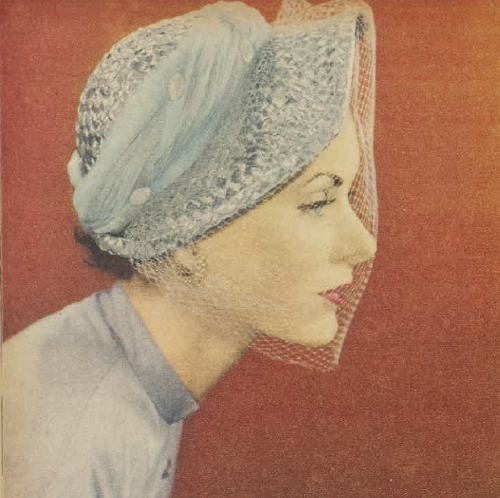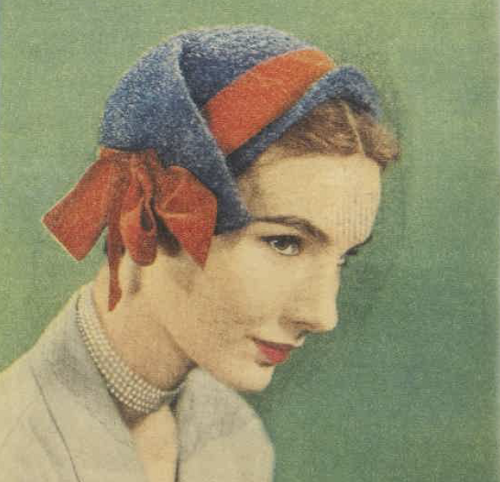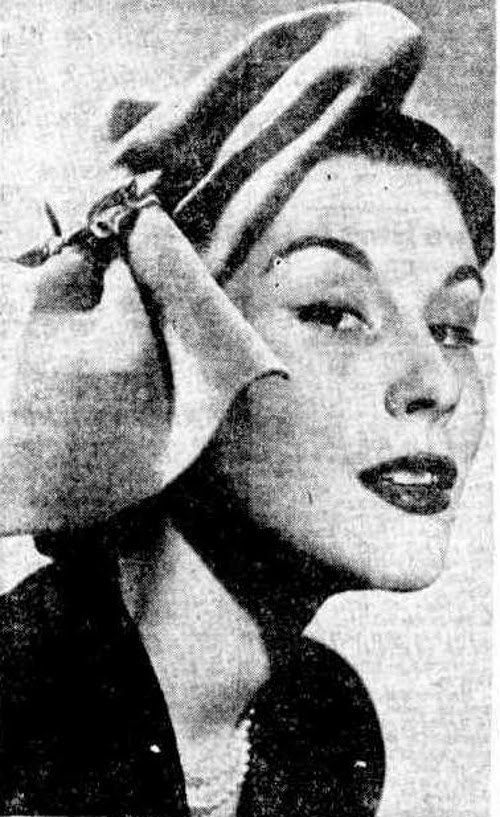The above illustrations come from Mary Horden's "Paris Notes" in The Australian Women's Weekly, July 25 1951. The article's caption tells us that "Veils and flowers are back, and ribbon, too, is important as a feminine accent."
I'm not much of a follower of modern fashion these days (I never was too much, but sometimes I tried). One thing I find entertaning is the need to be able to report on new trends. The need for there to be trends. It seems like we are being constantly told that something is "in" or "back" when I never knew it was out! Or when it has been "out" for only six months.
What I didn't know, was how much this was already the case in the 1950s! While you do see clear changes in trends as the decades roll on, the changes don't seem to happen very quickly (to me, looking back on it) and yet the papers and magazines have to have trends to show, have to have the expertise to make us need them. It just seems strange to me. I see the shapes change significantly, and the angles that hats are worn, but it seems to me like millinery trims stay the same most of the time. When was ribbon (all ribbon?) out? That doesn't seem very convenient! Oh well.
Back to Women's Weekly, this time from December 16 1950, which featured the above and below hats, suggesting that "If Santa Claus should prove a very understanding husband and slip a gift of money in your Christmas stocking to spend on "something just for you", a hat like one of these would find place of honor in your hatbox."
I can't disagree with you there, Women's Weekly.
In an article titled "Foremost Fashion Item in Paris is a New Hat", from Betty Wilson, Paris correspondent for Tasmania's Mercury (October 12, 1950), we are told that "The first item in any Parisian's wardrobe is a new Spring hat. Trimmed with crazy straw flowers, and straw feathers, too, they put a brave face on the dreariest day in early Spring."
Betty reports that the currently popular colours are gold, natural straws, and amber tones, and that checked, plaid and striped taffeta ribbons are common.
"Height, rather than width, is the Paris Spring trend. The forward-tilted, or "prow" line is important."
She mentions hat pins made with rosebud heads, in silk for spring/summer and velvet or tiny feathers for winter, which sounds like something fun to try. I've been keen to learn some jewellery making to make some hat pins, but haven't found the time, so this might be an easier way to start!
I'm very interested in this idea too: "In line with the new Paris craze for transformation dresses Paris modistes presented transformation hats too. The most popular has been Maud et Nano's amusing reversible bonnet, which, made of natural straw on one side and fine black straw on the other, can be turned inside out and worn to fit the day and the mood."
She mentions that "Gilbert Ocel's most successful spring hat was probably his "flying saucer" model - a flattish beret, which was worn straight and forward, so that it jutted out in the visor effect." This hat gets another mention in an article in the Sydney Morning Herald on May 18th 1950 about Mrs. Selwyn Waddell, the managing director of Moray Millinery Pty. Ltd. returning from a world fashion tour.
"Mrs. Selwyn Waddell wore a "flying saucer" hat from Paris and a plunge-neckline suit from Jaques Fath". She brought home thirty hats, some for herself and some to copy for her own spring collection, but said that "Everything was so expensive that I had to come home about a month sooner than I had planned."
The above picture accompanies a small hat fashion update in the Newcastle Morning Herald and Miners Advocate, 25 October 1951. "The latest trick of style in the hat fashion world is an accentuated side dip, effectively displayed in this draped fur felt model. The hat is in geranium red with a gilt clasp."
The Australian Women's Weekly from June 20 1951 tells us these trends:
"Hats are on the move, a forward move."
and:
"Hats for Spring are small and chic."
On November 21, 1951, the new update from AWW is that "A veil is the newest and most glamorous trim in millinery fashions." (Because no one was keen on veils before?) I do love the tiny bandeau veil in this picture.
Some final words from AWW, 22 August 1951. In the advice column "Dress Sense" by Betty Kemp, she is asked about the latest shapes and colors for spring and summer hats. As far as I can tell from Betty's response, practically everything is in.
"Neat, uncluttered sailor hats, hairline-revealing hats with wide sweeping brims; high, pointed caps, flat, coolie shapes; chignon caps, floral hats and caps, and an old-fashioned mushroom shape are all well represented in new millinery collections. Veils are in vogue. Some just cover the eyes, others the entire face, and in some case are jewelled or sequin-trimmed. Most liked colours are yellow, soft pink, lilac, and, as always, navy, black, and white. White looks newest with a colored veil."
My takeaway lesson from all of this is that it was just as confusing to keep up with fashion trends in the 1950s as it is now! At least when it comes to hats.
Still, I don't think a very understanding Santa could go wrong with any of these beauties. Any of these you'd like to see me make?








If you ever feel like making me another hat as a present for Birthday/Christmas, I love the blue one with the orange 'ribbon'. Absolutely gorgeous...
ReplyDeleteI'm sure I will at some point. That one is one of my favourites too!
DeleteI rather like the little pink one in the first picture. The green and white stripes is also wonderful but you'd have to have the right colouring to pull it off, I'd think. Not for the fainthearted :)
ReplyDeleteI adore the look of the green stripes as an illustration, but I agree it would be harder to get the look right in real life! The pink would be much more forgiving :)
DeleteWhy, hello, post and vintage images that took my breath clean away! :) Sigh! Swoon! Love!!!
ReplyDelete♥ Jessica
I'm glad you enjoyed them. The upside of my current drop in (millinery) productivity is that you will probably see more research and inspiration posts like this when I haven't been doing much hat making!
Deletegreat post I generally prefer 1920s, 30s, and 40s hats but these cute little 50s numbers are adorable
ReplyDeleteretro rover
I will, I hope, be getting to some of those decades later this year, but for now I'm glad you can still enjoy the cute 50s styles :)
DeleteThis is fantastic, thank you for digging all of this up. I know it shouldn't, but it always takes me a bit by surprise when I read or hear about some vintage item that we don't give much thought to now and realize that, just like us, there were distinct trends and fashions. To me it all seems so timeless, so it's funny to realize that some of my stuff might look wildly off trend to their eyes if I was transported back to the wrong year or something.
ReplyDeleteYou are welcome, I'm glad you found it interesting. It is funny to think about that, but I suppose that then, as now, many people were off trend! Especially people further from the centres of fashion and less in touch with current designs.
Delete